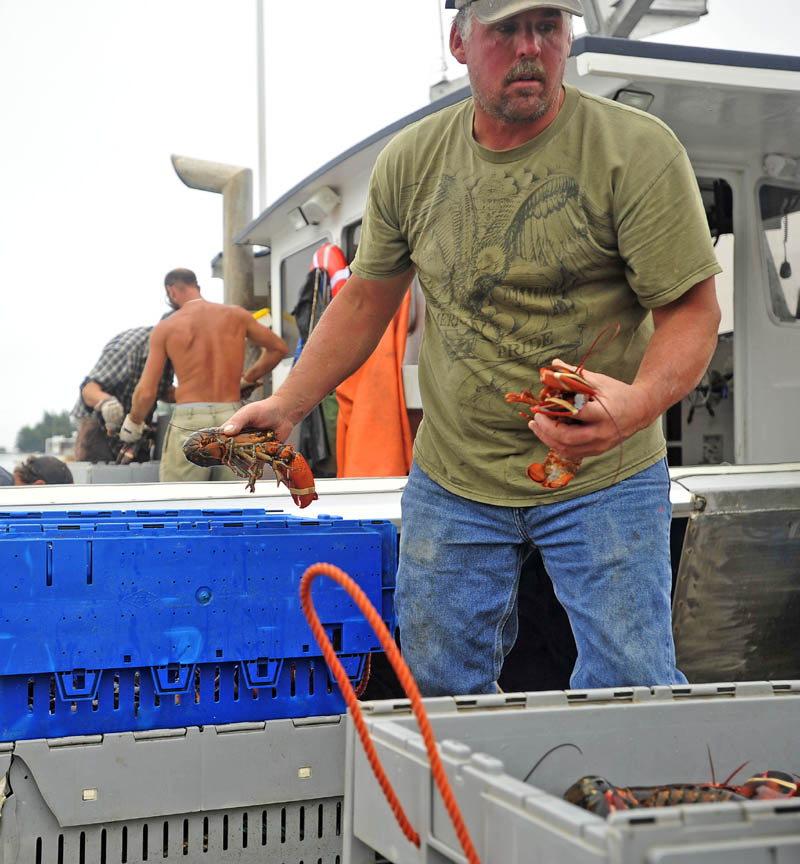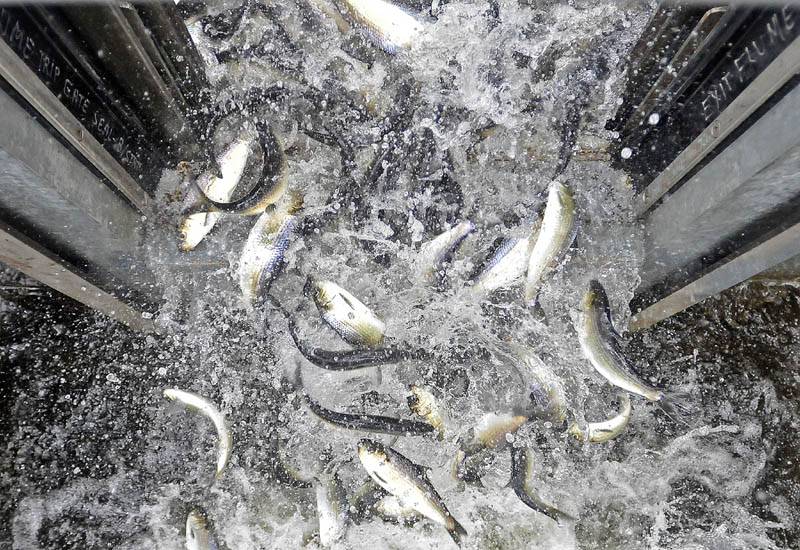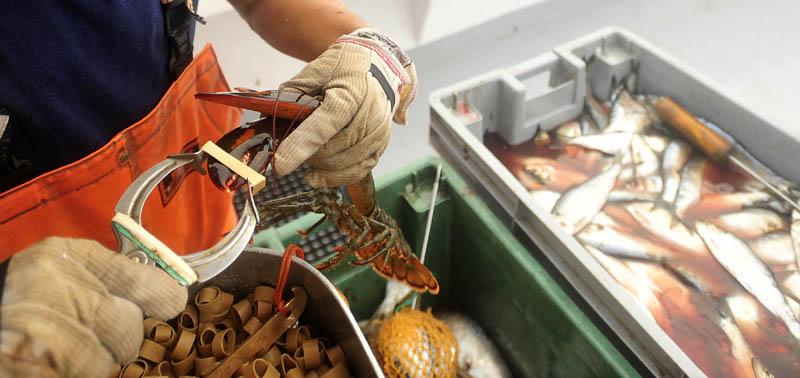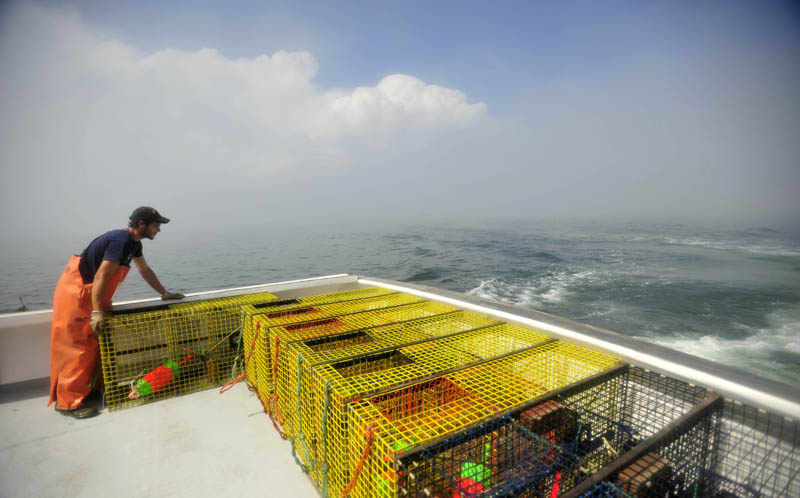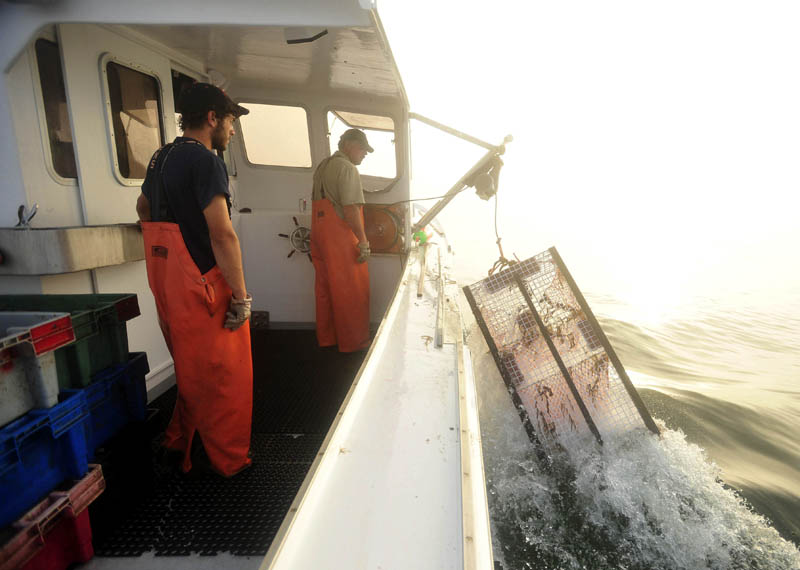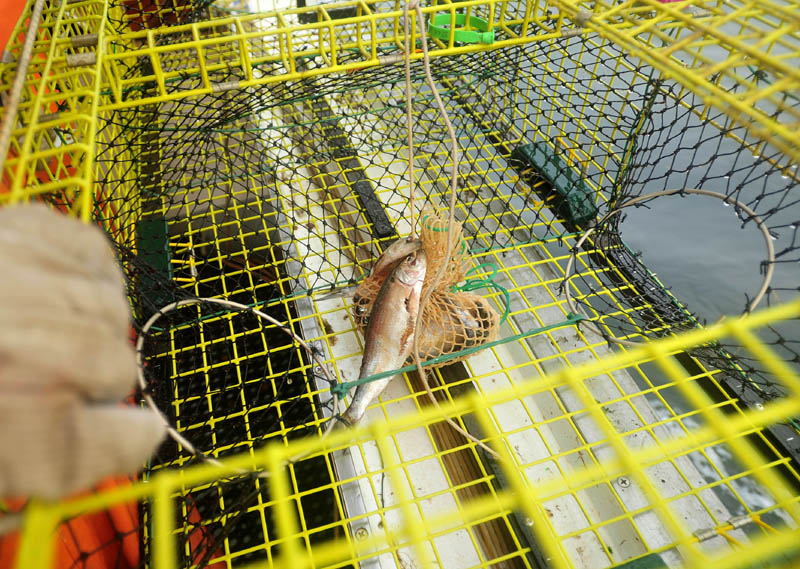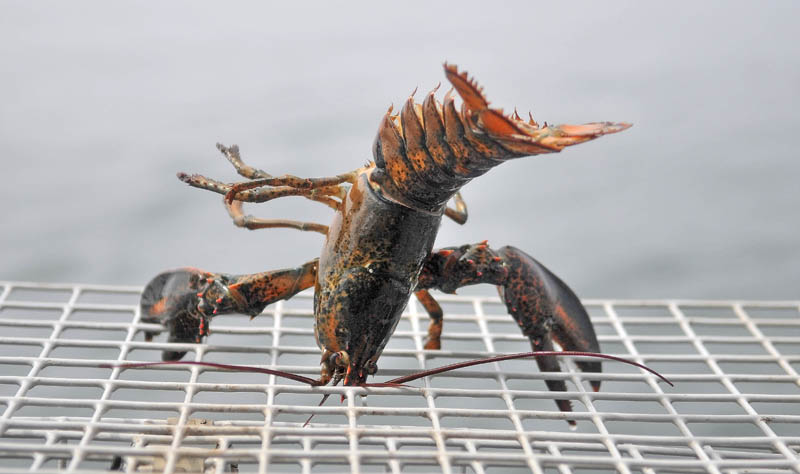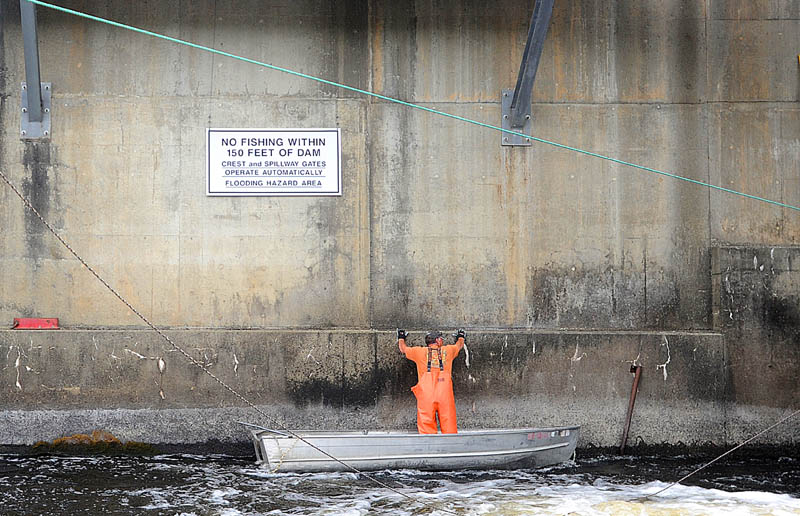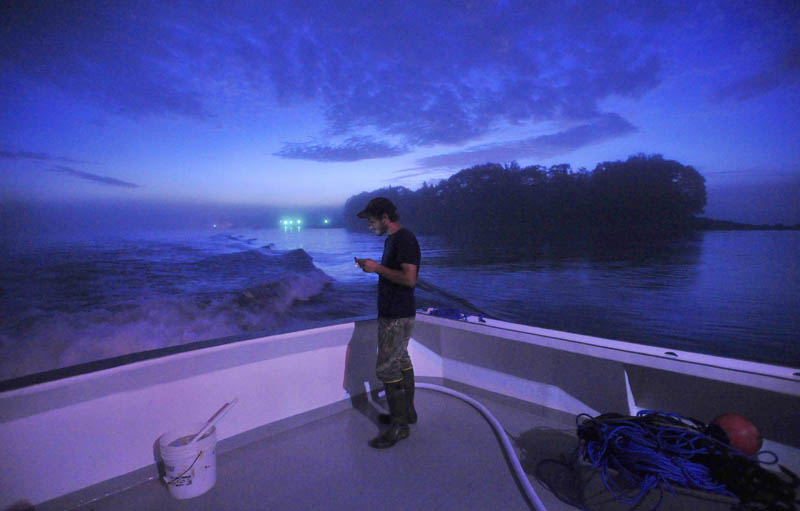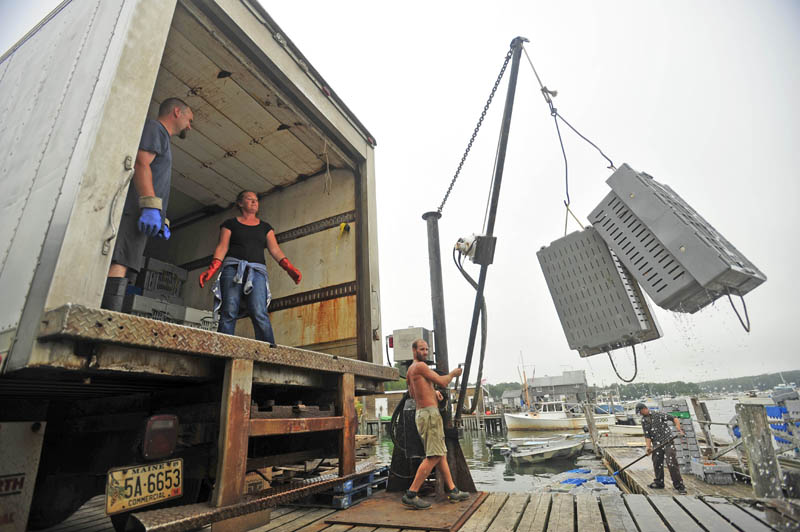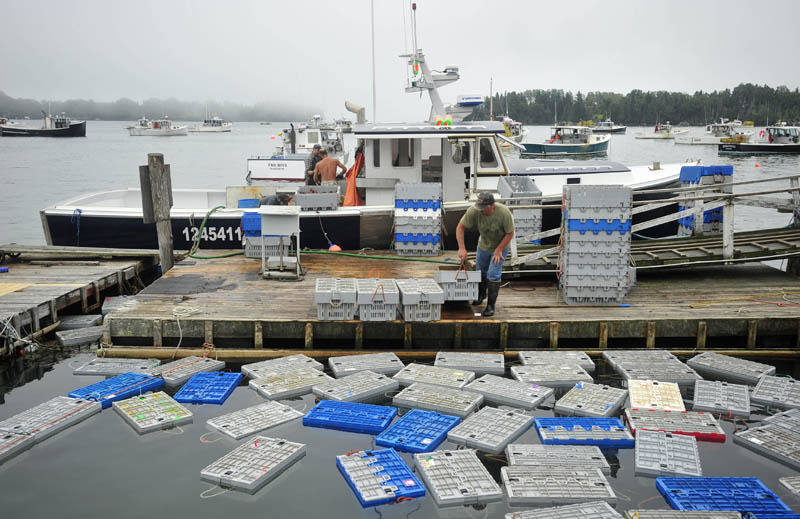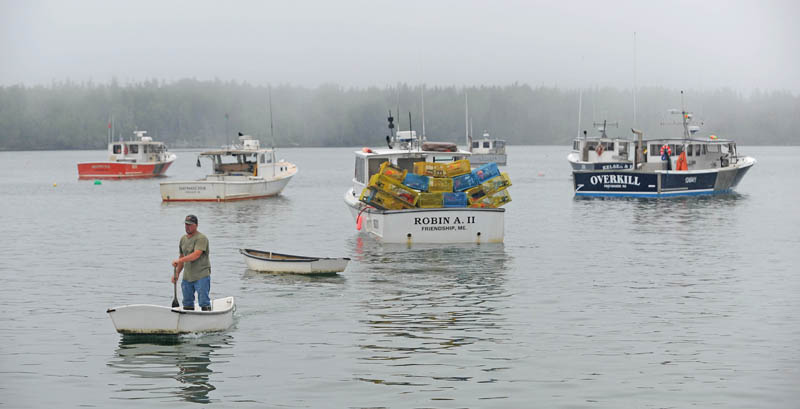At 3:45 a.m. in Friendship Harbor, Jim Wotton and his nephew were already working on the Friendship Lobster Co-op pier by bright moonlight.
Wotton, 44, of Friendship, is one of Maine’s authentic lobstermen, but he’s also taken on a second role in recent years that offers a look into the future. As a member of the Alewife Harvesters of Maine, Wotton has staked a claim in an up-and-coming industry that may soon be hugely important to Maine’s 6,000 lobstermen.
Wotton says no matter how many alewives hatch and are harvested, there will never be enough to fill the black hole of the lobster trap.
“We use a lot of bait,” he said. “There’s room to absorb all the alewives in the system.”
Hundreds of years ago, Maine was home to separate booming alewife and lobster industries, but a combination of dams and pollution wiped alewives off the economic map.
Experts say the recent removal of key dams in Maine rivers could increase the alewife population by five times, allowing the fish to outgrow their supporting role as bait fish and possibly even rival the lobster as one of Maine’s premiere natural resources.
On a recent early morning. Wotten worked in the fog and shadows cast by towering stacks of lobster traps. Wotton, who lives just a mile from the wharf, has bulging, Popeye-like forearms, wading boots and a ruddy red complexion.
He and his nephew, Carl Hayes of Waldoboro, trotted up and down the pier, establishing an urgent pace that would continue for the rest of the day and the rest of the season. And, very likely, for the rest of Wotton’s working life.
While Wotton got his boat, the Overkill, Hayes took frozen blocks of pogie, a bait fish, off a pallet and used his boots to break them apart so they would fit into trays. Mixed in with a half-dozen trays of pogie was one of alewives, brought from a stash in Wotton’s home freezer.
Other lobstermen were using only pogie, because they are preferred by the soft-shelled spring lobsters that would comprise 90 percent of the day’s catch.
But Wotton, who caught the foot-long, silver alewives himself from the Sebasticook River in Benton this past May, had a sense he could get some mileage out of the alewives, a favorite of hard-shell lobsters. If he could draw on his intimate knowledge of the ocean bottom to predict where the few hard-shells were, he could gain an advantage with the alewife, which is cheaper and lasts longer than pogie.
At the end of the pier, away from the stored buoys and rope coils, the two men used a motorized hoist to lower the trays to the boat, exchanging not a single word as they executed a well-established ritual.
The final load was two lunch coolers, containing a peanut-butter-and-jelly lunch that would provide more fuel than pleasure after the sun rose.
Wotton and Hayes piloted southeastward, leaving a small wake in a large ocean as they headed toward the first trap, between Allen’s Island and Mosquito Rock. Twenty minutes after arriving on the pier, they were gone — receding red lights on the still-dark water.
Wotton’s been fishing for 34 years, since he was 10. His father and his grandfather did too, using wooden lobster traps weighted with stones. So did his great-grandfather, Willy Wotton, rowing out to sea in a dory to pull up his catch. Nine generations of Wottons have fished this rocky bit of coastline for 200 years, a tradition that predates not only the town of Friendship, but the state of Maine.
If Wotton’s children carry on the family business by taking to the sea, Wotton will have to make sure there is a family business to carry on.
Right now, his sturdy sea legs are being tested in a way they never have before, as political, environmental, and market forces rock his boat. No one knows where Wotton, his alewives, his lobsters, or his children will be several years from now.
Diverging fortunes
Wotton gives everything — time, thought, energy and self — to his life as a lobsterman.
He has reason to think the alewife industry, with its potential to fill lobster traps with cheap local bait, is about to become a major player in the state.
For centuries, the river-born alewives and the lobsters of the sea bottom have had little impact on each other.
Wotton’s ancestors didn’t need to purchase a lot of bait fish during much of the 1800s and 1900s because, with smaller lobster trap lines, they tended to catch their own bait, he said.
When Willy Wotton and his contemporaries rowed from buoy to buoy, or hauled up the wooden traps by hand, they could manage lines of no more than 100 traps, compared to the 800 Jim Wotton handles now.
At the beginning of the season, before the seawater permeated the wood, the traps would have to be weighted down with rocks. They were also less durable and needed frequent patching, laborious steps that limited the number of traps one could use.
During that era, alewives, which saw as many as 100 million fish spawning every year, were widely harvested, but not for use as lobster bait.
In freshwater ponds and lakes throughout Maine, alewives hatch out of eggs by the billions and head for the sea. They spend four years traveling thousands of miles up and down the coast, at which time they mature sexually and battle their way back to their hatching grounds. Those that survive spawn and renew the cycle.
During their upriver run, they are a food source for many species, including humans, who would take off work to harvest their share, according to Jeffrey Pierce, executive director of the Alewife Harvesters of Maine.
In the early 1900s, alewives were used as a fertilizer, and as cat food. As recently as the 1950s, they were commonly eaten as smokers, a term Pierce said still has some currency among old-timers, who fondly remember the New England pairing of a smoked alewife and a glass of beer.
A handful of river systems, such as the Penobscot and the Kennebec rivers, each have dozens of contributing rivers, each of which has a town that holds fishing rights to that river’s alewives. These fishing rights, some of which date back to the 1700s, remain in effect in more than 40 towns today.
In the mid-1900s, as industry and technology boomed, it became easier to haul lobsters and to log Maine’s forests, but it became harder to survive as an alewife.
When people began building dams along Maine’s waterways, primarily to serve the wood industry, the path for alewives and other spawning fish, such as eels and the Atlantic salmon, was blocked. Pierce said pollution made the fish inedible, which reduced public outcry about preserving fish passages.
Alewife populations crashed, and have never recovered.
Surging alewives
But now, the alewife population is growing, just when lobstermen like Wotton might need them most.
One sign of the alewife’s growing importance is the existence of the Alewife Harvesters of Maine, founded in 2007 with just six members.
Since then, the membership has grown to 160.
Eighteen members are harvesters, and Pierce said the rest are environmental organizations, professors, salmon restoration advocates, and alewife enthusiasts — a quirky crowd that so loves the alewife they will go to great measures to help them spawn. Pierce said members have tried to install culverts to help the fish through a collapsed stone wall, or have organized schoolchildren to lift fish over an obstacle in buckets. A North Haven man, he said, is even paying out of pocket to have alewife stocks carried to the island community by ferry.
The alewife harvesters and environmental groups have successfully lobbied for many of Maine’s dams to either be taken down, or equipped with fish ladders and elevators to allow fish passage.
Wotton and a small crew harvest alewives at the Benton Falls Dam on the Sebasticook River, a tributary of the Kennebec, one of 21 current alewife runs in the state. The dam’s owner, Essex Hydro, installed a $1 million fish lift that carries the fish up and over the dam. Once a certain number have been passed, Wotton and other harvesters get to work, netting them from the water and crating them for sale.
Benton usually earns $15,000 to $20,000 from its alewife run, with twice that going to the working harvesters.
Over the past year, fish passage has been granted through dam removals or modifications at the Great Works dam on the Penobscot on Indian Island; Sappi Fine Paper’s Westbrook location on the Presumpscot; and the Grand Falls dam in Baileyville on the St. Croix, which resumed fish passage after a legislative vote in April.
There are also projects in various stages of completion or consideration on the Randall Mill dam in Pownal on the Royal River; the Milford and Howland dams on the Penobscot; and the Veazie Dam in Eddington on the Penobscot, opening 1,000 miles of habitat.
In addition, three hydroelectric dams on the Mousam and Kennebunk rivers in southern Maine are under federal review.
Pierce said the sum of all that activity will be millions more alewives, though he estimates it will take seven to 10 years for the numbers to grow significantly.
But there’s a problem.
The cat food and fertilizer industries have long ago turned to sources other than alewife, while human consumption of smokers has shrunk considerably, making the fish a resurgent natural resource in need of a market.
But the lobster industry, it turns out, is a market in need of a local natural resource.
Every spring, supplies of pogies and river herrings, both of which are fished under state quotas, start to run out, driving up the prices for the lobstermen who use them as bait fish.
“There’s some guys that go without bait,” Pierce said.
Some lobstermen turn to frozen bait from Asia, an increasingly expensive option as climbing global fuel prices make transportation more expensive.
An estimated 11 million harvested alewives weren’t nearly enough to fill the needs of the lobstermen this year.
Wotton said he would have liked to have taken more himself during the Benton harvest, but he restrained himself.
“We decided not to hog them all for ourselves,” he said. “We sold what we could sell, up until the last couple of days.”
Cooperation could be temporary
Right now, the lobster industry needs the alewives, and will continue to need them for the foreseeable future.
Whether the alewives will always need the lobster industry is less clear.
In the 28-day window of legal alewife harvesting in Maine, the fish generate $6 million annually, Pierce said, while the year-round lobster industry generates about $100 million.
But as billions of alewife eggs are laid in newly accessible breeding habitat in the Saco River, Cobbossee Stream, the Kennebec River and other Maine waterways, things will change. The St. Croix alone will produce at least 11 million, and possibly as many as 20 million harvestable fish, while the state total could be 60 million in 10 years.
However, Pierce said the supply of alewives will outstrip the demand of lobstermen.
“Right now, lobster bait is easy and quick,” he said. “There’s other markets that can be opened up.”
For alewives to ever catch up with lobstering as an economic engine, the industry will have to not just grow, but diversify, Pierce said.
“If you see the St. Croix coming with 11 million alewives, you better have a plan in place,” he said. “Smoke them or salt them or turn them into compost. The next opportunity’s around the corner.”
He would like to explore, once again, those traditional markets of cat food and fertilizer. Composted alewife is organic, he said, which could help it to earn a place in the growing trend of organic farming. And Pierce said the association sells about 2,000 smokers each year at summer festivals in an effort to grow the number of Mainers who think of the alewife as a tasty treat.
In Canada, he said, alewife harvesters salt fish to be sent to third-world nations like Haiti as sustenance food.
The most tantalizing possibility for Pierce would be to sell the alewife eggs, or roe, to Asian markets as a delicacy, at a price point that would be a major coup.
“A pound of roe is a hundred bucks,” Pierce said. “A pound of alewives is 30 cents.”
A hard day’s work
For at least the next several years, it seems Maine’s harvested alewives will wind up in the stomachs of Maine’s lobsters, benefiting two industries at once.
But if one of the alternative markets for alewives takes off, the marriage of their interests could be short-lived.
By planting one rubber boot-clad foot in each industry, Wotton has positioned himself as well as he can to handle the uncertainties created by a market in flux.
On the Overkill, Wotton and Hayes went from buoy to buoy, where he and Hayes hauled each trap up, sorted out the legal lobsters, added fresh bait, and lowered it. They did it 300 times in 12 hours, about two and a half minutes for each trap.
The pace is punishing, but Wotton says it’s necessary.
“You have to work hard all day to make money,” he said.
Not until 9 a.m., with five hours of hard work behind them, did they break even on bait and fuel, Wotton said. It took longer to pay off boat maintenance and insurance costs.
Wotton has concerns about the health of the local lobster population. Maine’s conservation efforts are working, he said, but he worries about a regional sea-change that could crash the population entirely.
He doesn’t accept the term global warming, but he knows climate change is coming, and that warmer seas can be bad for lobsters. From his vantage point on the northernmost edges of the New England coast, he’s watched as lobster industries in southern climes collapse.
Wotton has three children, two teenage girls and a 7-year-old boy, named Myron after the boy’s great-grandfather.
The girls run a licensed lobstering line, but they haven’t committed to it as a career choice, he said. For now, it is a more lucrative alternative than working at a fast food restaurant.
“The job will be waiting for them if they want to,” he said. “I’m not going to force them into it, because it’s not for everybody.”
The same is true for Myron.
As he finished a 12-hour day at sea, his catch sold to the co-op, Wotton planned to stop home for a quick supper, and then bring Myron back to the pier for a couple of hours, to tackle some of the 20 hours of weekly maintenance work needed.
“He’ll catch mackerel, I’ll paint buoys,” Wotton said.
Myron helps contribute to the family business in his own way, donating his evening’s catch to his father’s stores of lobster bait.
If Myron, or his older sisters, do carry on the family tradition, Wotton’s early positioning in the alewife industry may help them to keep their footing in the business. It is, like the sea, always the same and ever-changing.
Matt Hongoltz-Hetling — 861-9287
mhhetling@centralmaine.com
Send questions/comments to the editors.


